In 1856, an Augustinian friar by the name of Gregor Johann Mendel began a series of experiments in which he studied the hybridization of pea plants. In his experiments he would select a specific trait (such as height), cross breed two pea plants that displayed this trait in distinctly different ways (such as cross breeding a tall pea plant with a short one), and then study their offspring. His observations about the mechanisms in which traits are passed from one generation to the next ushered in a new field of science that we know today as genetics.
Overview
In the game of Genotype: A Mendelian Genetics Game (which I’ll just call Genotype from here on out) the players take on the roles of research scientists working on the grounds of Mendel’s monastery as they try to understand the workings of genetic inheritance and use this understanding to cross breed different pea plants to achieve desired outcomes. Over the course of the game the players will be collecting Pea Plant cards, each bearing a set of desired traits. Using a combination of worker placement and dice drafting, the players will be collecting the traits needed to complete the requirements shown on the cards in order to score points. After 5 rounds of play, the player who has accumulated the most points wins.
This is just a high level overview of the game. If you just want to know what I think of the game, feel free to skip ahead to the Thoughts section. If you’re interested in learning how Genotype is played, read on. Any unfamiliar terminology you encounter during the setup will be explained later.
Planting the Garden (setup)
To set up a game of Genotype, the main game board is placed in the middle of the table and the coins and trait cubes are placed off to the side in their own supply. Next one coin is placed on each of the four empty slots next to the Punnett Squares (which come in four different colors that represent different traits) on the left side of the board. Just off to the side of the Punnett Squares is where the matching colored dice and Parent Gene Tiles should be placed (green next to green, red next to red, etc.). The matching dice are rolled and placed according to the rules that I will set out in the Observing Results section.

Moving over to the right side of the game board, you’ll place the round marker on round 1, place the research funding upgrade trackers on their starting positions of the various research funding upgrade tracks, and then fill up the Nursery and Tool Shed card displays with face up cards from their randomly shuffled decks. The Nursery area is where the Pea Plant cards are placed and the Tool Shed is where the Tool cards go. The remaining cards are placed face down in their respective decks close by along with all of the research funding upgrade accoutrements (research assistant cards, extra plot tiles, research funding upgrade tiles, and 2 player shovels for each player color).
These player shovels are part of a set of 5 in each player color. The players will select a color and then collect the shovels (minus the ones set off to the side) and the phenotype markers in their chosen color along with a player board, 1 coin, 3 Pea Plant cards drawn from the top of the deck, and 1 Tool card drawn off of the top of that deck. After selecting a Pea Plant from their hand to plant into one of the plots on their player board, one to keep for later, and one to discard, the players will select a starting player who receives the start player token and then you are ready to begin.
Experimentation
The game of Genotype is played over a series of 5 rounds each consisting of several unique phases (which are conveniently shown on the game board in the upper right hand corner): worker placement, dice drafting, upgrades, and upkeep. In the first phase, beginning with the start player and going clockwise, players will take turns assigning their workers to the different action locations around the board. Here’s a quick rundown of what those different spots are and what they do:
Setting Parent Genes (1 for each different color): If there’s still a coin here, the player takes it. This allows a player to alter the parent genes so that the offspring dice in future rounds will produce different results (this will make sense later).
1st Shift (1 for each different color): If there’s still a coin here, the player takes it. During the dice drafting phase, the player taking this action will get first dibs on the dice of the appropriate color.

2nd Shift: After the 1st shifters choose their dice, the 2nd shifters take turns drafting dice from any of the different colors. The importance of this and the 1st Shift space will become clear when I start talking about the dice draft.
Set Research Goal: A player claiming these spots will earn bonus points at the end of the game for any completed Pea Plant cards which bear the matching traits. For instance, if a player uses this action to place one of their phenotype markers on the rr spot, they will earn 3 points at the end of the game for each of their completed Pea Plant cards with an rr on it. This is why the Setting Parent Genes action is such a useful one. By tweaking the offspring results, you increase your chances of producing the traits that you’re after.

Lecture: The player going here will receive 2 coins from the supply.
Take Cards From the Nursery: The player choosing this action takes a number of Pea Plant cards from the face up display equal to the number printed on the action space. These cards are added to their hand. There is no hand limit.
Take Cards From the Tool Shed: Depending on the chosen action space, the player selecting this action will either take a face up Tool card from the display or 2 face down cards from the Tool card deck. These cards are added to their hand unless the text on the card states otherwise. Tool cards provide rule bending benefits such as the ability to cover multiple traits (which we’ll get to), performing certain actions out of sequence, or gaining coin for performing certain actions.
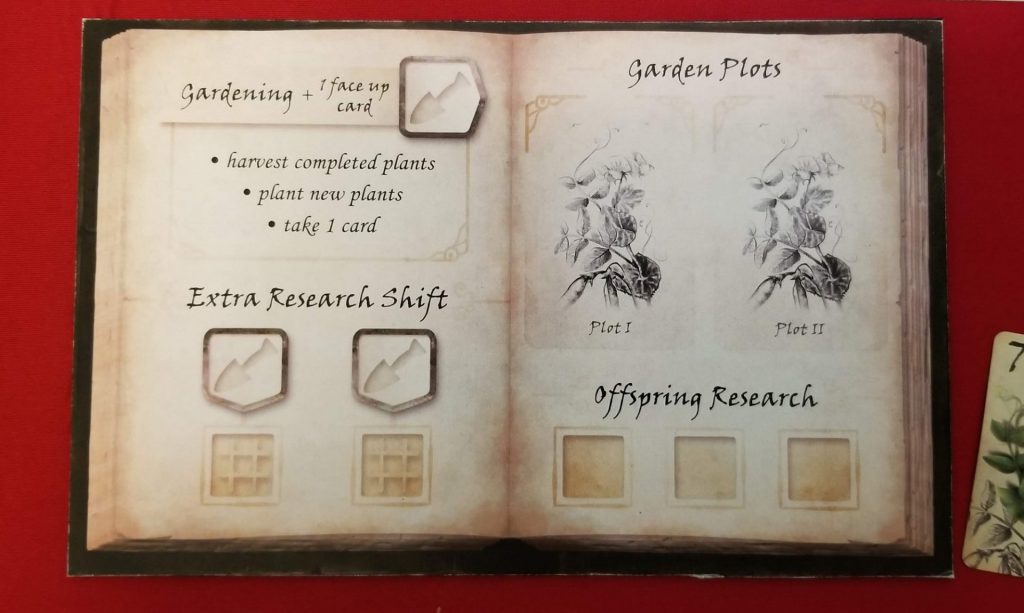
Gardening (an action on the player boards): The Gardening action is broken into three different sub-actions that can be performed in any order and as often as the player is able to perform them. These are:
- Harvest completed plants: remove the trait cubes from any Pea Plant cards which have all of their traits covered and then add the cards to your score pile.
- Plant new plants: place a Pea Plant card from your hand into an empty plot.
- Take 1 card: take any one face up card from the Nursery or Tool Shed and add it to your hand. Each Research Assistant (this is one of the research funding upgrades which we’ll get to) allows the player to take one additional card.
Extra Research Shift (an action on the player boards): This action unlocks a temporary spot to place dice drafted during the next phase.
Observing Results
In the second phase, the players are going to take turns drafting offspring dice and using these in order to fulfill the various trait requirements on their incomplete Pea Plant cards. These dice are initially rolled during setup but will be rolled during the cleanup phase for the remainder of the game.
One of the players will collect all of the dice and roll them. Next the dice are divided by color then number and compared to the Punnett Squares. Finally they are placed into the offspring die spots accordingly. At the beginning of the game, for instance, if a green 2 is rolled, that die is placed into the Gg offspring spot.

The dice drafting begins at the top of the left hand side of the game board and moves downwards by color (blue, red, green, yellow). Anyone that has an action marker on one of the 1st shift spots will draft from the color matching the 1st shift action that they selected. They are followed by the 2nd shifters in the order that their action markers were placed. After the 1st and 2nd shifters have drafted their dice, players continue drafting dice in turn order.
When a player drafts a die, that die will be taken from a certain offspring spot. The player places the selected die onto an empty research die spot on their player mat and then places one of the trait cubes from the supply onto a trait that matches the trait the die was selected from. For example, if a player removed a die from the rr spot, they would place that die into an empty research die spot on their player mat and then place a trait cube onto an uncovered rr on one of their Pea Plant cards.
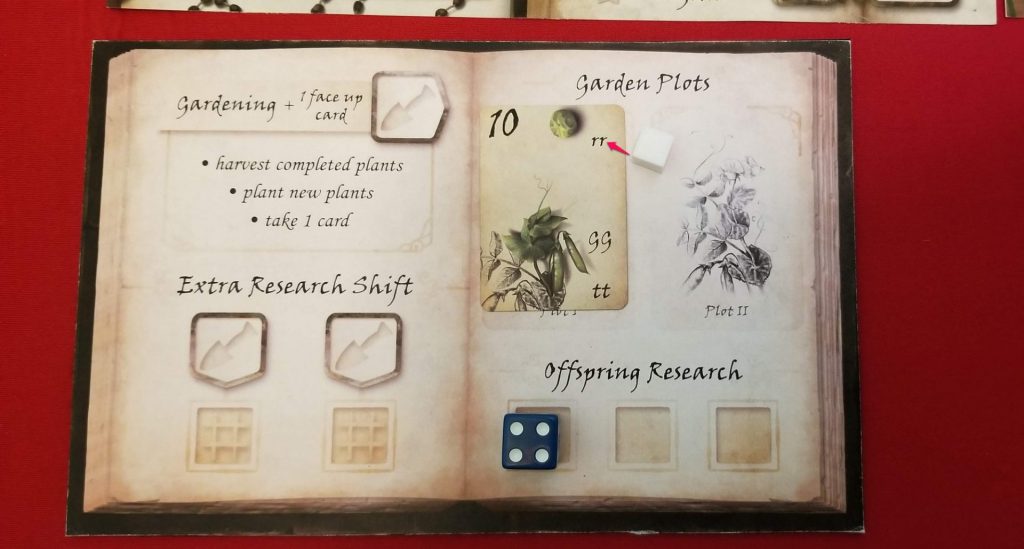
If a player drafts a die from one of the De Novo Mutation spots they have two choices. They can either take a free coin or they can use the die to transform another die of the same color into a different offspring type. For example, a player can take a blue De Novo Mutation die to transform an Rr into an rr. Both the De Novo Mutation die and the altered die are placed into empty research die spots. If the player does not have two open spots, they cannot choose this action.
Players will continue taking turns drafting dice until nobody has any research die spots left. Then the next phase begins.
Research Funding
In reverse turn order, the players will have the opportunity to spend their coin in order to obtain research funding upgrades. These upgrades come in four different types and a single player may only ever possess two copies of each one during the game. The different types and their effects are:
Add a new plot: take one of the empty plot boards (if there are any left) and place them beside your player mat. Pea Plant cards may be planted here.
Research upgrade (add a dice slot): take one of the dice slot tiles (if there are any left) and place them beside your player mat. Offspring dice may be placed onto these in future phases.
Free up time: take one of your shovels and place it next to your player mat. You will now be able to perform one additional action in future rounds.
Hire a research assistant: take one of the research assistant tiles (if available) and place it next to your player mat. During future Gardening actions, you will be able to draw an additional card.
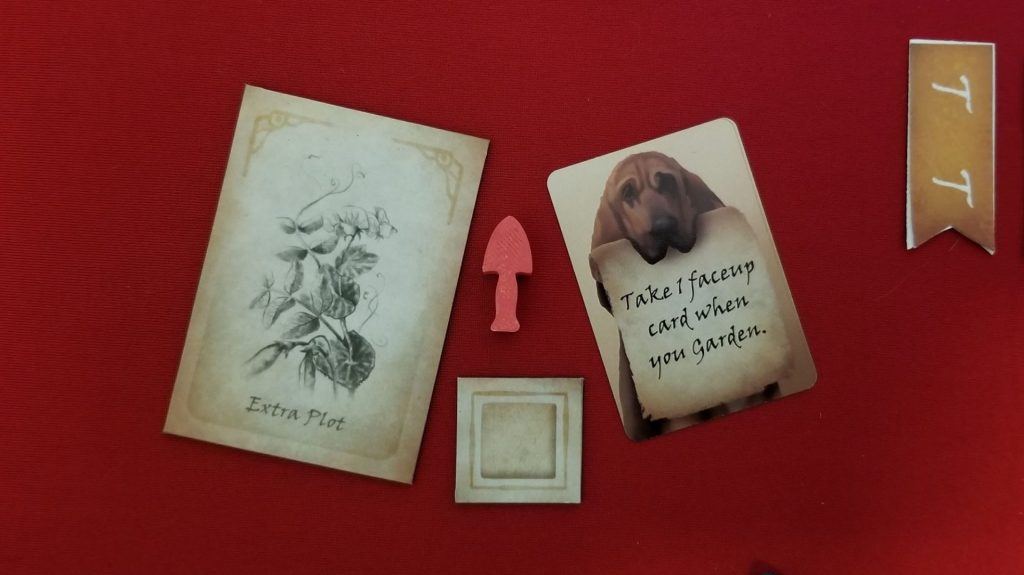
When purchasing a research funding upgrade, the player pays the price shown and then adjusts the price marker up by one. This has the effect of making the same upgrade more expensive for the next person in line.
Players take turns purchasing upgrades until they cannot or do not want to purchase anymore and then a clean up is performed. The action markers are collected and returned to their owners, new coins are placed onto any empty slots next to the Punnett Squares, the price of every research funding upgrade is reduced by 1, the start player token passes to the next person in clockwise order, the round tracker advances, and a new round begins.
The End of the Study
The game ends at the end of the fifth round. Then the players tally up their points and the player with the most points wins. Points can be gained from:
- Completed Pea Plant cards
- Research goals
- Trait cubes left over on incomplete Pea Plant cards
- Left over coins
Thoughts
The first thing that caught my attention about Genotype was Tomasz Bogusz’s gorgeous illustration of the front cover. We find ourselves looking down at the surface of a table. On this table rests a journal that’s been well worn from heavy use. Several pages have fallen out of their binding and on them we can see meticulous handwritten notes. The subject of these notes lie scattered about the table’s surface: peas. With one single image, he has conveyed everything that this game is about. And it doesn’t stop there. As you delve into the game you’re constantly assailed by the highly agreeable aesthetic that he’s created. Tomasz Bogusz’s work has graced many of Genius Games’s titles such as Subatomic, Cytosis, and Periodic and I’ve always been impressed. But if you ask me, this is his best work yet.
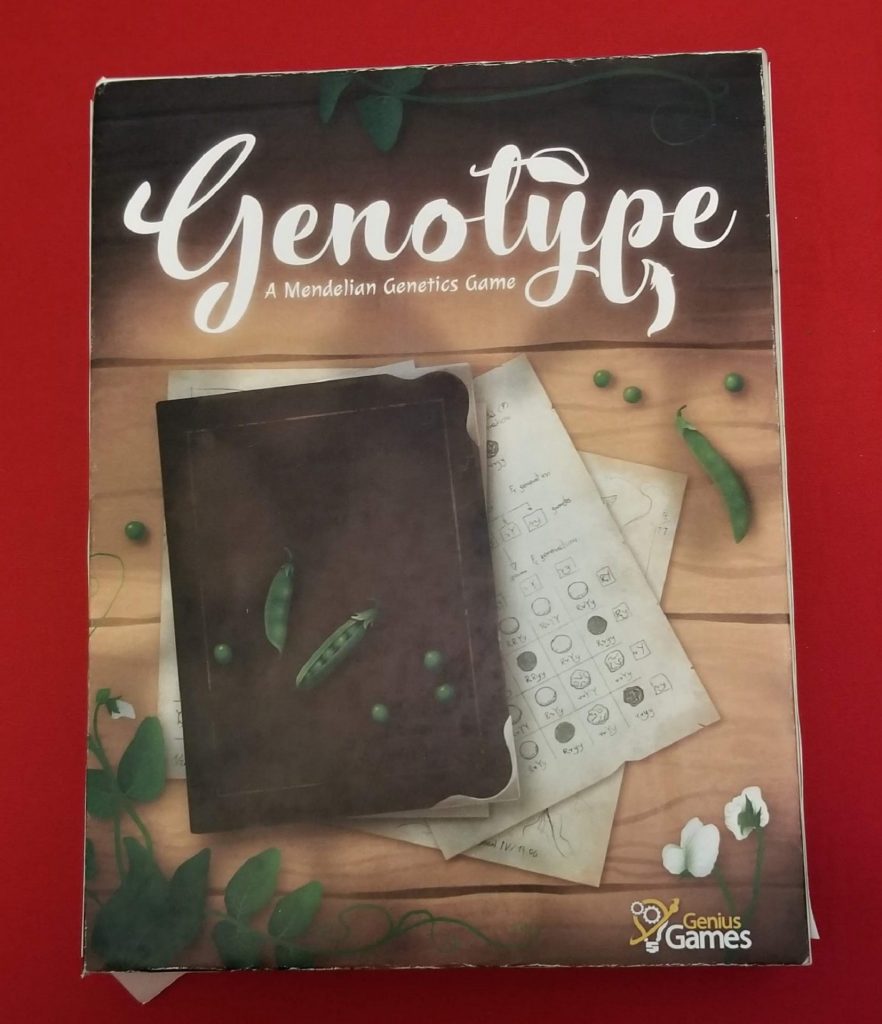
Tomasz’s artwork isn’t the only thing on display in Genotype, though. The game play is pretty good, too. At any given time, Genotype puts you in the predicament of having to choose between increasing your scoring opportunities by getting more cards, earning coins to make your turns more efficient, specializing in order to score more end game points, or spite drafting to deny your opponents. In a perfect world you’d be able to achieve all of these things. There would never be any tough decisions to make and you’d have all the time in the world to bring your plans to fruition. But this is Genotype and in true worker placement fashion, time is short and every plan you conceive will almost assuredly go awry as soon as your opponent places their first action marker onto the board.
Core to the game is the dice drafting and this is where the meat of the action takes place. Oftentimes there will be competition for very specific offspring types and only one of those types will actually roll. If you’re the first player, taking the 1st shift spot in that die’s color would seem the obvious choice but if you do that, you’re giving your opponents first dibs on everything else. Is being the person to get that die really that important? Is it the most efficient action to take? Are you giving your opponents an advantage over you by trying to get that one particular die? Genotype often forces you to have to reassess your priorities and you never know whether or not you’re making the right call until the final scores are tallied. I’ve tried different strategies in different games and none of them seem to be any better than the other. It’s definitely a game that keeps you on your mental toes.
The game’s only real shortcoming is that at a 2 player count, the board feels too open. At higher player counts you get in each other’s way all the time. However, with just 2, there’s always some useful option open to you. You are rarely faced with having to pick between the best of several less than stellar options like you do in 3 or 4 player games. That’s not enough to keep me from playing, though. Even if the game does suffer somewhat at a 2 player count, it’s still a lot of fun.
Lastly, Genotype’s brilliance lies not just in the game design itself, but in the way that it’ll have you scouring the internet to find out all that you can about Punnett Squares and De Novo Mutations. That seems to be the trademark for all of Genius Games’s offerings; they present you with a fun gaming experience while also fostering in you a genuine curiosity about the world around you. And that’s what keeps me coming back to Genius Games time and time again.


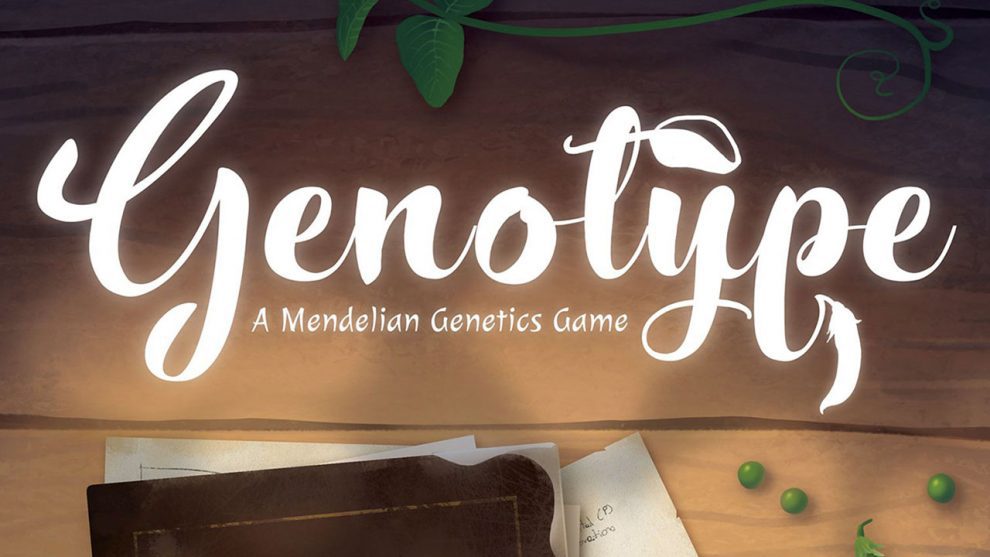

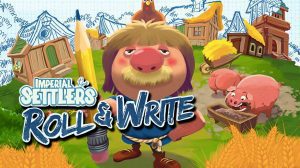

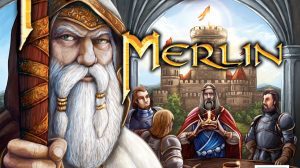




Just pledged this game on Kickstarter! Thanks for the review. This was helpful, as I almost always boardgame with 3 players.
Will have to check out Genius Games, as this game sounds fun. Thanks for a wonderful review.